Joseph Yaeger

Imagery seems to play an important role in your practice. Can you talk a little bit about the use of imagery in your work and what gravitates you towards particular images when you decide to paint?
There are two primary aspects to the use of imagery: subconscious, which almost always comes first, and conscious.
It's funny you use the term 'role' in your question, as my manner of painting might have certain things in common with acting––albeit in the inverse. In the same way an actor might use the Strasberg technique to mine his or her own psychological history to inform the role they're playing, to give it depth and feeling and believability, the imagery I use is a protracted search to better understand myself; playing or putting on roles that might clarify an interior that is sort of naturally hidden, even from myself. That's the subconscious part of it, or the part that, when asked, I have to acknowledge that I simply don't know. I'll come across an image––sometimes I'm searching for one, sometimes I stumble into it––and the feeling of it, the arrangement, the subject, the relation of subjects within the image, will sort of jar me, attract me, dislodge me. I'll rubberneck and feel almost physiologically some tug or shove from the image. Probably it's not so different from the impulse so many people evidently have to photograph a dramatic sunset, it's just that for me I'll get that urgent feeling from, say, an eyewash station. That's the subconscious part.
The conscious part is what happens with or what I do with the bank of subconscious images I've collected into an archive (a fancy term for a series of folders on my desktop). After compiling a number of images, I'll begin naturally to draw comparisons or link one to the other. (The obsessed detective searching for the killer––the cork-board, tacked photos, lengths of red yarn, newspaper clippings––comes to mind.) This doesn't necessarily mean they're dependent on each other––my hope is that each painting stands on its own––but I find that tethering them helps shift their native context, turns them into metaphors moving as a single body, an expanded three-legged race.
There's a Patricia Lockwood quote from an essay called 'How Do We Write Now?' that goes: "Think about what isn't in poetry yet that you could put here." Possibly it's grandiose to think in such terms, but then I'm also aware that my paintings are not enormous departures from the sources from which they derive, so taking away emotion and handling and materiality and cropping (all of which are really important, but on the level of actual painting) they become essentially about (1) the source and (2) the act of painting it. Certain images I become extremely, almost fetishistically, obsessed with. For days I'll wait eagerly to translate them into paint, already celebrating how great and meaningful the painting will be. And of course ten times out of ten these become the most vivid failures. And every time––somehow I don't learn––I realise it's because the image was already a painting. Which is perhaps the final part of selecting imagery: it can't already be a painting. Or the work of what makes it a painting can't have already been done for me. There has to be room in the image for it to transcend itself, for discovery to be made, and for the discovery to be an answer as to why or what aspect of the hidden self it illuminates. I don't frankly know yet how to identify this pre-painting, but once I'm painting––sometimes I can tell within three or four preliminary brushstrokes––it's as if my whole consciousness is ringing like a struck tuning fork.
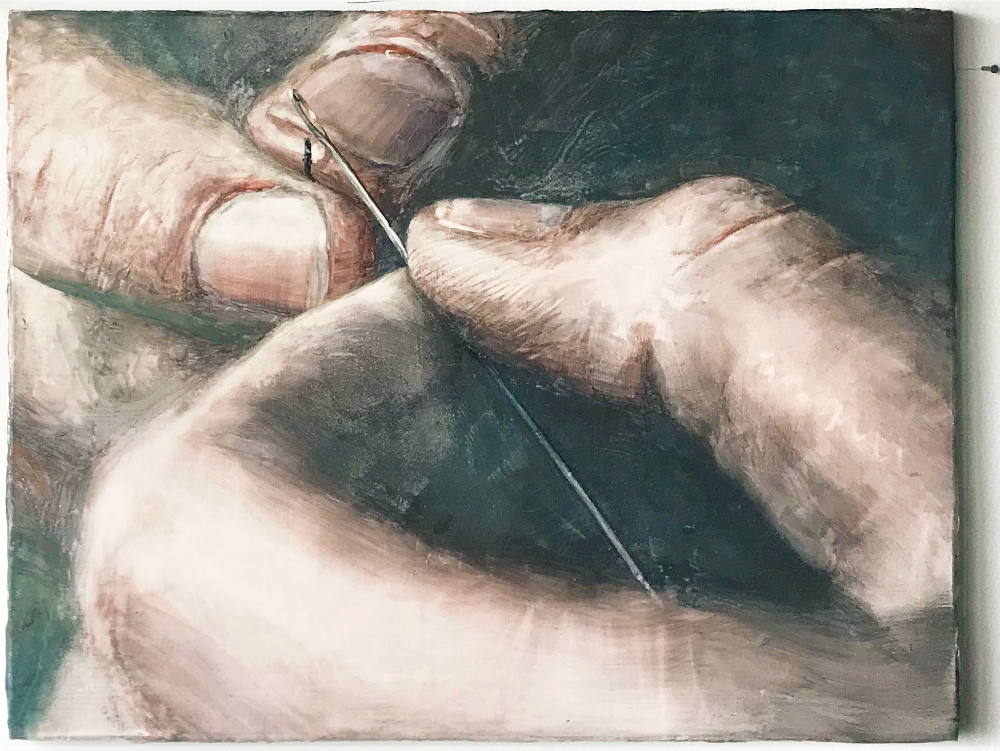
You mention a detective like approach to discovering the meaning of the subconscious reactions and feelings that these images invoke. Do you feel like your paintings have begun to grant you a clearer view on some of the themes there, or is it still an ongoing enigma for you?
Both. Almost by its very nature the process or endeavour of observing one's interior is enigmatic. (If it weren't I suspect you'd have thousands of therapists and psychoanalysts out of work.) It's a bit like Whack-a-Mole––some piece of the self pops up and you address it and you feel good about addressing it, but of course the very action of address triggers some other mysterious aspect to emerge. And you continue from there.
That said themes do coalesce. Myopia (sight), hands (action), activated picture planes/images within images (subjectivity). Lately, I'm drawn to the notion of a 'hidden meaning.' As in: there isn't necessarily a hidden meaning, but the painting is about hidden meaning. It seems to me that so much of contemporary life involves engaging with hidden meanings that in the end were somehow both meaningless and visible.
I remember once at a show of mine I was having a conversation with two quite serious and engaged collectors––a married couple. They were interested in a painting I'd made of a hole or abyss with a rope ladder and some flexible tubing dropping somewhat forebodingly into its void. At the time I'd titled the painting 'Body', thinking about the abyss of our own interiors, how we're for the most part hidden from ourselves (on the flight... but who's the captain?, this sort of thing). Anyway they said they liked the painting but found the subject too dark and violent, which confused me at first, before realising they thought it was about a body being down the hole! Like a murder or some Silence-of-the-Lambs-type scenario. I was gobsmacked––this had, I'm embarrassed to say, never occurred to me, and it was revelatory; of course a person would take a painting's subject at face-value depiction, or inject narrative, as if it were an illustration. But this is exactly how I don't think of painting. Off the top of my head, I can't think of a single painting of mine that is about what is depicted.
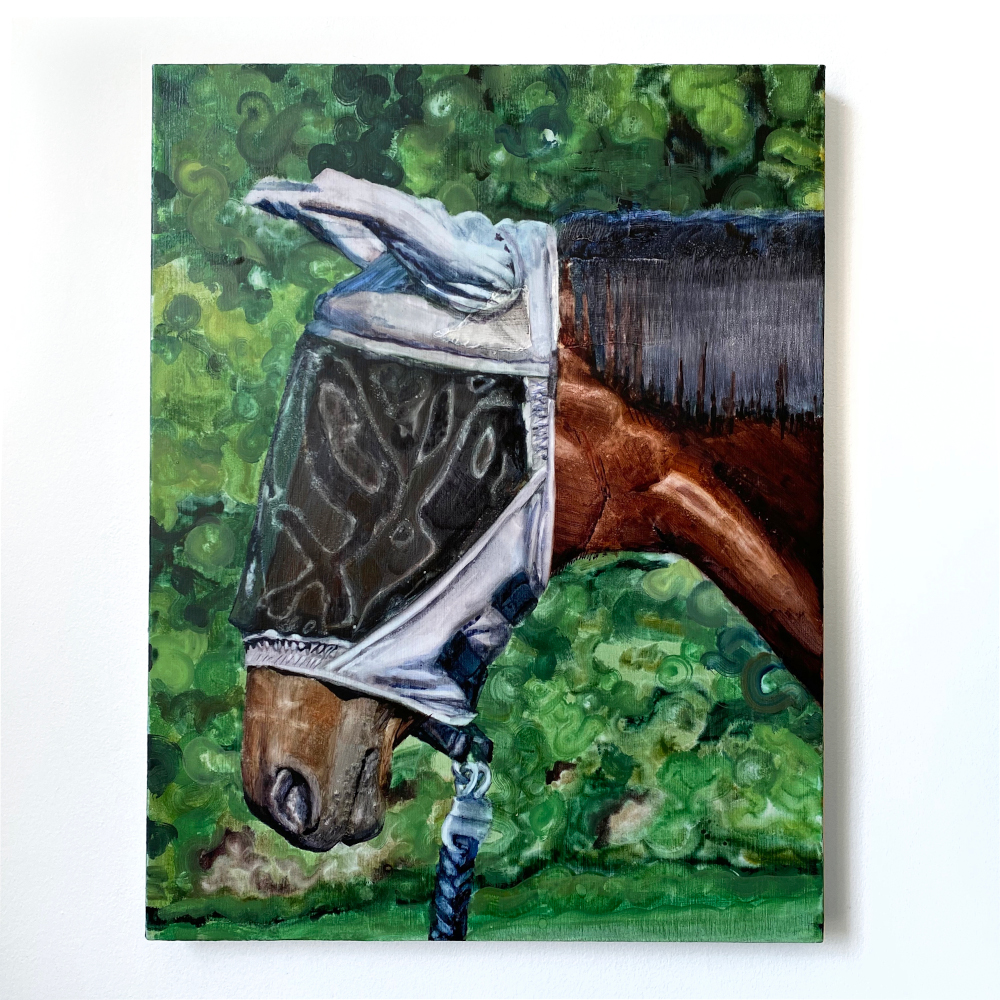
The story about the collectors' alternative interpretation leaves me intrigued to understand your thoughts and feelings about the relationship that viewers have with your work, and what they take away from it. Could you talk a bit more about that dynamic and how, if at all, it affects your practice?
So for about six years, I worked as a cheesemonger in a very serious (absurd as it sounds) cheese shop in central London. This was one of these places––in fact, I think the first place in the UK––with a walk-in temperature- and humidity-controlled room and about 300 varieties of cheese from all around the world. And the staff in the cheese room were seriously passionate and knowledgable. Intimidatingly so. We'd tasted all the cheeses in the room at all seasons hundreds of times and could get obnoxiously granular on tasting notes. Knew provenance, milk-type, breed of sheep or goat or cow, herd size, production method, Latin names of all moulds, etc. It was pleasurable to carry so much expertise, however something that couldn't be ignored or avoided was no matter how good your palate was, and how much background you yourself had accrued on a particular variety, if a colleague said, 'I taste raw cobnuts,' or 'tahini' or 'braised cabbage' you would invariably taste what they said. No matter the input––the actual sensory taste––language still dominated your perception. All of which is to say I really don't like telling people exactly what I was thinking whilst I was painting something. Or what I'm hoping to convey. It seems ancillary to the endeavour. Plus it's never the whole story, because the image isn't language.
That said, if we're talking straight-up Golden Rule reciprocation: yes, for artists I admire I will voraciously read any and all interviews they've ever given, and whether I agree with what they believe their work is about or not, it is (usually) a pleasure to hear them talk about it. So if you bore down into both your question and my previous answer's anecdote, it seems to me we're just talking about control. More specifically ceding or reinforcing it.
At some point I just sort of loosed my grip, ceded control. I realised that every meaningful encounter I'd ever had with a painting was predicated upon an individual lifetime of associations and experience and memories... personal references you might call them. It's why certain Wyeth or Hopper or Dodd paintings just slay me, no matter how I feel about these painters or their paintings in an 'objective' or critical or coldly analytical sense; I see one of their paintings and feel in my bones: I have been there. And why is this sensation so moving? In other words, it seems to me we always give more to a painting than what is there. Or at least I do, so I assume everyone does.
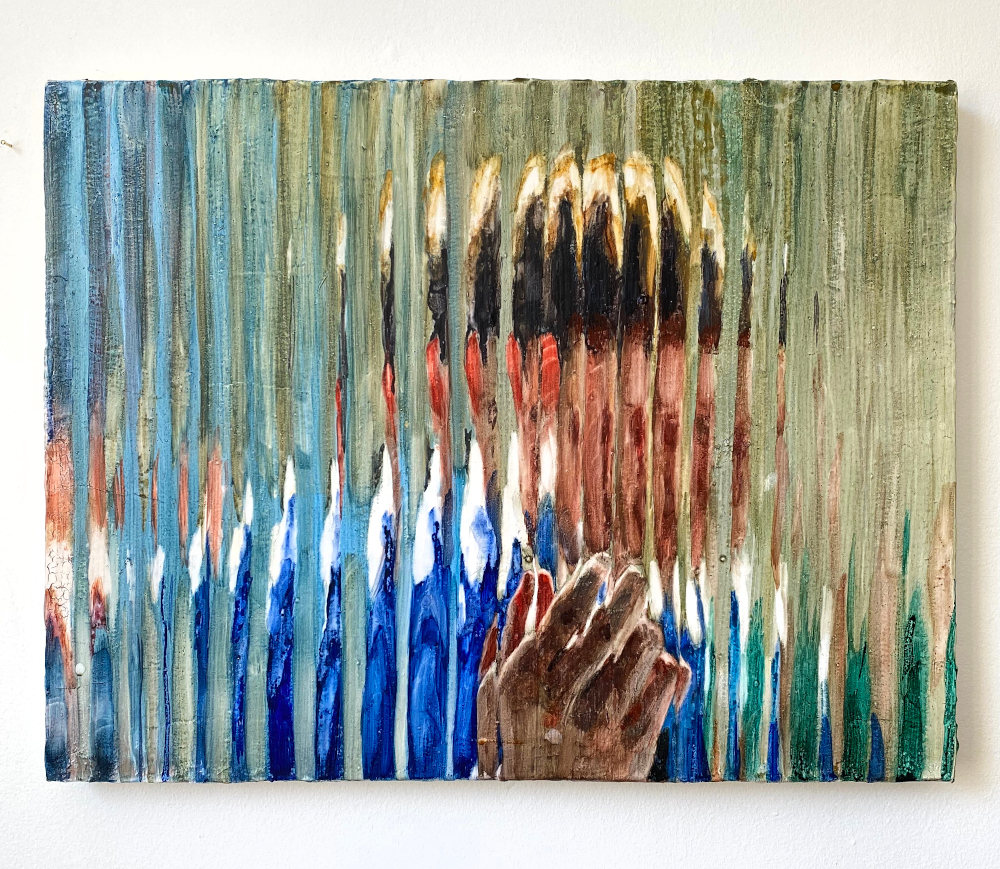
The desire to avoid giving a prescribed meaning is an understandable stance to take. However, having seen the use of materials like hair and tobacco in previous works, I am left intrigued whether you view your materials lists and titles as cues towards certain sentiments?
In their respective 'functions' I regard the two separately––the titles and materials, that is––so I'll start with materials.
The tobacco and the hair, neither of which I've used in at least a year, grew out of a set of circumstances quite organically. Or a state of mind, say. The stretch of time during which I was implanting hair and tobacco and studio detritus into the gesso/painting surface I look back upon and realise I was basically just gussying up nihilism. I think I thought I was going to die at any minute, which sounds very dramatic I know. But because I didn't have a clear sense of the future––or seriously doubted its viability––the paintings took on or reflected the burden of that thinking. My belief at that time was that all work, or all painting rather, was really very transitory. Nothing lasted very long. Of course, painting here is a metaphor for the self, one's lived existence. I was quite death-obsessed. This produced a strong yearning to create something that might outlast me. Thinking about how the body (the structure of the canvas) carries and maintains the mind (the painted image) and how if I placed hair and tobacco (suggestive of both the body & the materials it consumes) directly into the painting that perhaps even if the image someday faded away the painting would somehow remain. So there was yearning there. I had read Walter Isaacson's Leonardo biography and was intrigued in a sort of deflated way how, given enough time, the half-fingerprint in certain of Leonardo's drawings takes on as much importance as the drawing itself. We essentially just crave evidence. We want not only to look at the painting; we want to imagine the artist, embodied, creating the painting as well; a window and a mirror simultaneously. So those materials were an attempt to insert myself very literally into the work. To sort of create and then sanction off microselves, replete with DNA, should anyone have the perversity to test it. I suppose you could say there's a sentiment in there, but it's pretty pitchblack.
The titles are tied more directly to what we've earlier discussed. The aspiration is not always to elucidate, but to suggest rather that the image is not just the image. It is a painting of an image, and being a painting, it carries a centuries-long lineage of symbolism. Historically speaking a scythe is never just a scythe, a crow never just a crow. Granted all of those symbols were tethered to religion and were made to be 'read,' so I wouldn't call it a tragedy when the 20th century took that notion and shoved it Fargo-like into a woodchipper, but at least for myself the title denotes my thinking, my internal logic or how I interact with the external. (I also don't think I'm alone in this; a cursory scroll through Instagram and the dearth of memes suggests that a considerable subset of the population finds real joy in dislocating an image from its original meaning by overlaying it with new language. What I'm intending to do maybe isn't so different, it's just eschewing a punchline.)
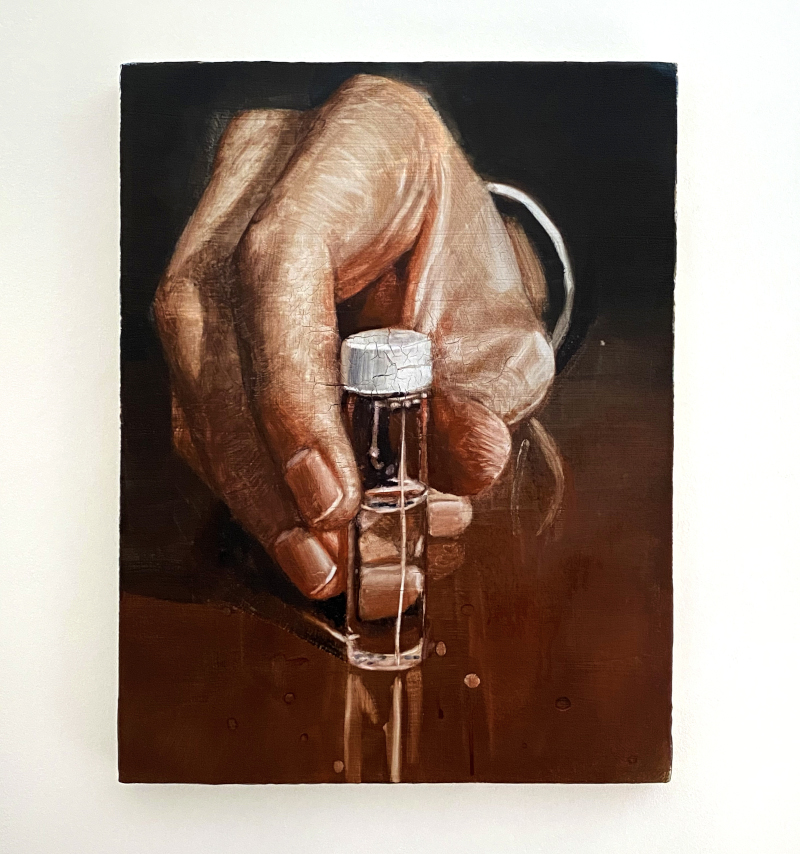
You allude to the fact you haven't used those materials in over a year, which makes sense as the works that were in my mind there were from your graduate degree show. I would be interested to get your perspective on if you feel your work has changed since graduating from the RCA?
The work is always changing or developing or evolving from within. I don't know if that's totally evident from without, but that's the feeling. Otherwise, I see no reason to be painting. The notion of stagnation is horrifying.
For the degree show the stakes felt enormous. It felt as if I had to express everything I'd ever thought or felt and that my whole life hinged upon this one show. Then I graduated and realised that that entire stretch of time, the MA, was simply getting to the starting line––personally important, but really quite fledgeling. In the broader scheme of things, say a twenty-year stretch, almost juvenalia.
During my final year at the RCA I changed up my entire practice, moving from watercolour on paper to the more active (and challenging) watercolour on gessoed canvas, so in the year since I've graduated––on a purely technical- and/or medium-level––I think the paintings have become more complex. Larger and sharper, more patient. There's also this thing young novelists experience; it's said one draws from their entire life to write their first novel, so the second book is in some sense the test of whether a person is actually a writer. Not exactly analogous, however I feel traces of this. My degree show was a sort of vast de- and then re-constructed self portrait––a prismatic exploration of my knee-jerk obsessions. Then it was done. I took a couple of months to decompress, then delved more deeply and with greater focus into what exactly the paintings were doing. I couldn't, or can't, write another roman-à-clef, as it were, so it's only now in preparing paintings for my first solo exhibition that I'm jigsawing works together under a more focused theme.
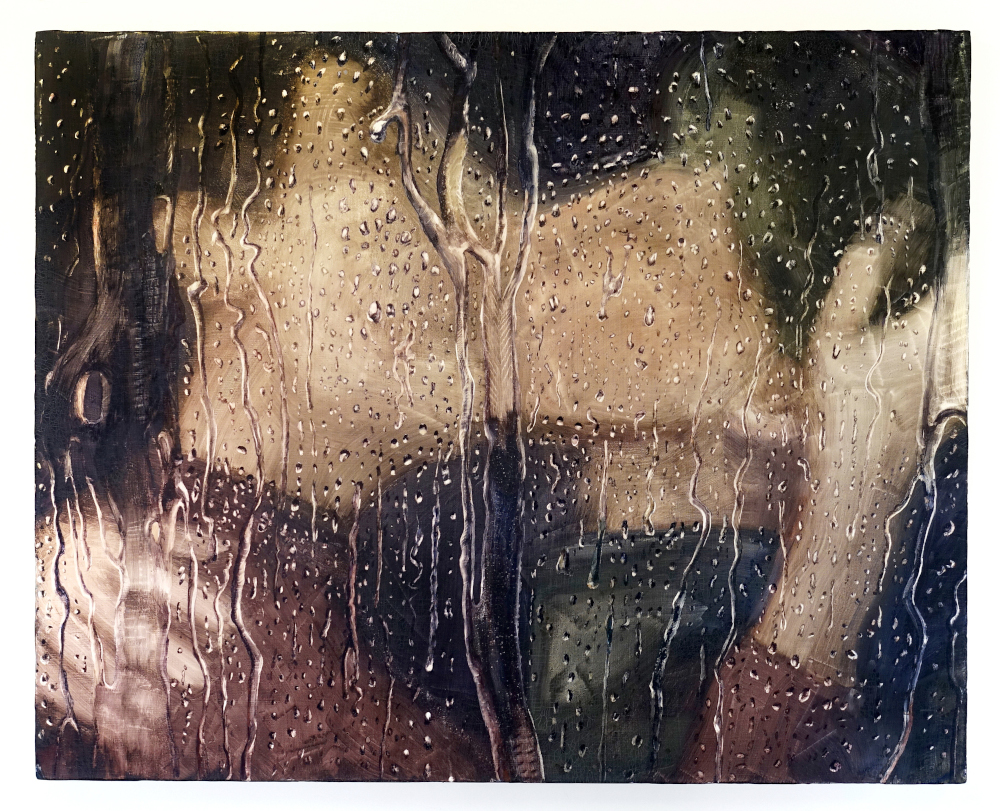
I wanted to move onto something else that feels like it could be pertinent, which is your upbringing in the US. American cultural references appear to permeate through some of your works, and I wondered if you could delve into the significance of that a little bit for us?
I think your use of the word 'permeate' is quite apt here, as it's a relatively passive verb, and if the cultural references of growing up in the US seep into the work, the decision is––at least for the most part––incidental.
A tutor of mine, another American, once told me that the root difference between American and English sensibilities is that the US is an image culture, whereas the UK is a literary culture. While I don't think this is universally true––or maybe it's just a bit reductive(?)––I will acknowledge that growing up in the States is to be inundated with images in a way that Europe just doesn't seem to be. It is aggressive, and it is exhausting, and if you've never spent time out of it (I first left small-town Montana at the age of 19) I don't think you can really get a sense of exactly how unrelenting and overstimulating it is. When I visit the States these days I'm really bothered by the ubiquity of televisions, advertisements, billboards. They are seemingly everywhere, unavoidable, and while I grant that a majority of today's world spends hours of each day fixated on their phones, it is altogether different for one's public space to be invaded by the noise of––for the most part––advertising imagery. There is, it seems, less 'empty' space. I realise it sounds like I'm whingeing, and to a degree I suppose I am, but an auxiliary benefit to this bombardment, at least for me, is a kind of resultant democratisation. In my work, as in late capitalist American life, the hierarchy of imagery is flattened; an image of a bottle of Johnson & Johnson baby powder holds exactly as much meaning as a crucifix or Phillip Seymour Hoffman's last known photo or a crop circle.
I also believe deprivation causes sensitivity. I grew up in pre-internet Montana. It is difficult to convey just how culturally isolating this was. Whatever was fashionable in New York in 1992 was available in Montana (as derivative JCPenney knock-offs, mind) by about 1994. People drove ten or twelve hours to Portland or Seattle to shop for clothes and when they returned it was as if they'd been to the moon. I was deeply afraid of big cities. My only connection to the rest of the country––the 'world' in American parlance––was accessed through television (I had one in my bedroom) and more specifically through the advertisements between shows. And there were so many of these! (I genuinely cannot imagine what growing up with the BBC must have been like.) At a very young age I understood that a sitcom's length, though broken up into half-hour programming slots, was twenty-two minutes long––meaning over a quarter of every hour of television watched was to be under the spell of commercials. Just this week I read in the NYTimes that scores of my compatriots watch YouTube compilations of '80s and '90s commercials to––get this––relax, and even more fucked up is this makes sense to me.
I suppose in this manner it's something like a blind person's keen hearing. Images, uniquely American images, having been ubiquitous, for me have their own sort of meta-depth. Behind each image are vectors pointing every which way. They interrelate and communicate and are seldom straightforward. They self-reference. In the work this creates a kind of inward logic, and while it may be fractious, it at least gestures toward a constellation of feelings or meanings that for me, when it works, feels very true.
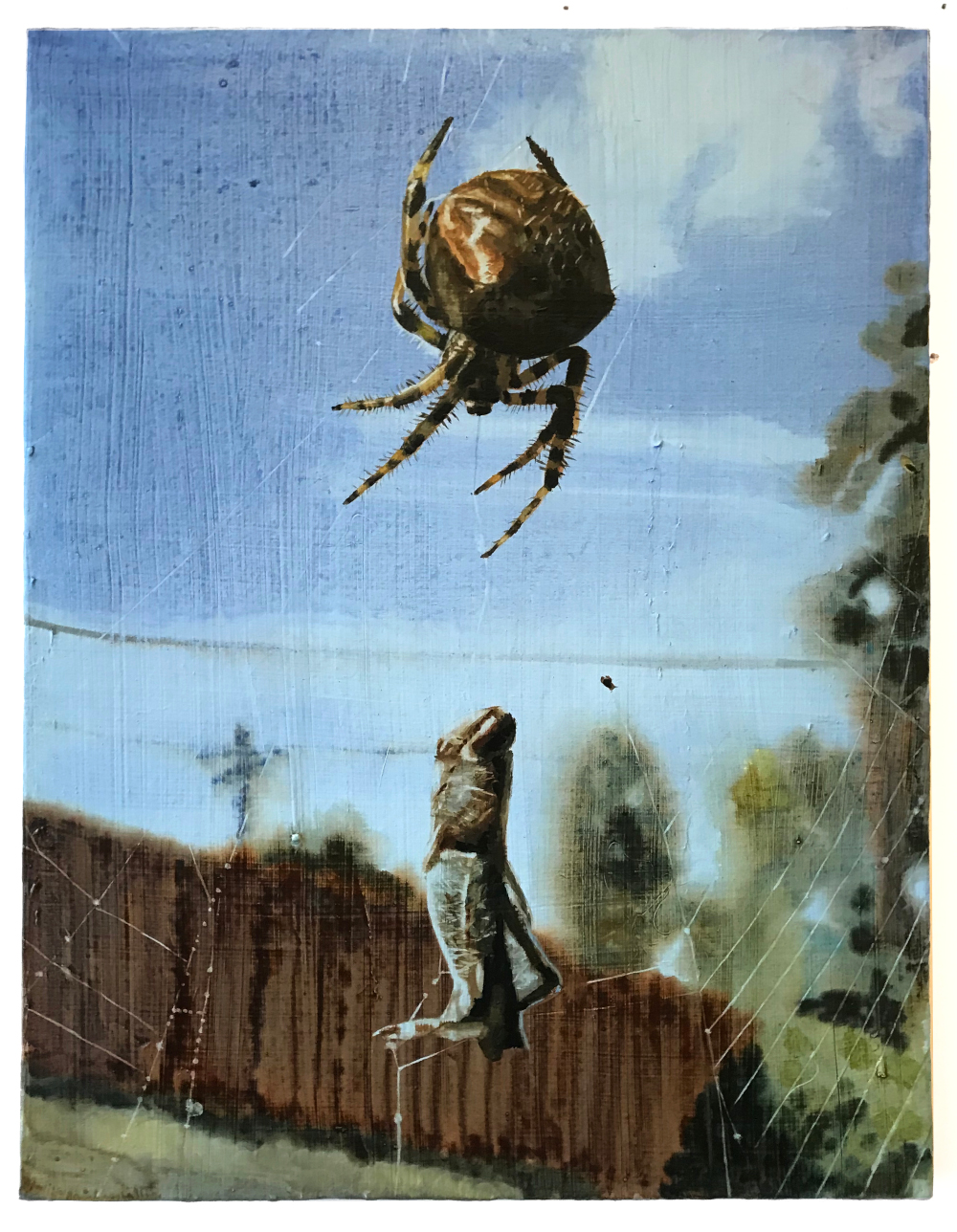
Having looped back to the topic of imagery, one element that would be great to dig a bit deeper on is the topic of its transposition in your work. You mentioned in a previous answer you're conscious your paintings can be at times visually close to their source. Could you talk a bit about your relationship and history with visual fidelity in your practice, and also if you feel it has any impact on your distinction on a work being a Painting or a painting of an image?
Yeah, I wouldn't even say I'm conscious of the fact that they can be close––I would say I endeavour very deliberately to keep within the source's bounds, editorialising as little as possible. To drag a photograph (a form approached, generally speaking, with credulity) over the fence into painting's lineage is, or ought to be, complicated.
In her Paris Review interview Amy Hempel talks about how, in her first fiction seminar with Gordon Lish, she was given the assignment to write a story using her 'worst secret' as a starting point. I like this exercise in that it encourages dealing with shame; accessing it and in so doing removing its claws. For me, starting back in undergrad, I had this real fear or shame that I didn't exist in the work, or that the only self-expression within the work could be described by an absence or lack. This suspicion caused me to flail ('experiment' would be the euphemism) and for a long time my work suffered. I fabricated numerous perspectives, styles, approaches, all the time fueled by a strong paranoia that I was fraudulent––an imposter. The great irony is that I was an imposter, though for the most part in an inward-facing sense. Eventually, I just admitted to myself that maybe the most fruitful thing to do would be to paint out of that shame (I have this theory that pride and shame are in fact identical feelings assigned different valences), which led me to my current practice. I thought: if I take a verité approach, and attempt faithful transcription using no projection or drawing or gridding or any drafting trick or tool, just free painting, then the gap between the source and the painting will, in its metaphorical negative space, reveal my hand by default. This is why many of my paintings appear photographic when photographed, but are, in person, actually quite brush-stroked or 'painted.'
Back in high school, early in high school, something happened that I consider deeply formative: I won a poetry contest with a plagiarised poem. It happened as a last-minute thing––I hadn't written anything for the contest so the night before it was due I put on a song and quickly copied down the lyrics. I handed it in, won, and I was overcome by guilt. I admitted what I'd done to my parents and teacher––disappointing everyone––and as a punitive measure it was decided that I would have to compose an original poem and read it at some sort of poetry evening: little theatre, podium, spotlight, microphone, the whole shebang. Anyway I did that and all parties seemed proud that I'd learned my lesson.
Here’s the thing though: fifteen years later I was cleaning out my closet in my parents' house. I found a big tupperware filled with papers and photos and basketball cards, all my adolescent detritus. And after some aimless digging I happened to come across the poem––the original printout of the plagiarised one––and in an instant remembered the whole episode. The regret, I found, had become wistful. On a lark I pulled out my phone and googled the lyrics. Reading the two side-by-side I was surprised––pleasantly so––to find discrepancies. In fact many of the real lyrics weren't even close to my transcribed ones. It turns out the poem I thought I'd plagiarised could have been thought of as a conceptual piece about translating heard language into written language. It isn't exactly analogous, granted, but I do think my practice retains as a principle this sort of natural gap of mistranscription.
So that's the perhaps first part of your question.
The second part is the refinement of this notion. Why do some paintings work? It's arbitrary, but I've come to think of finished works as Paintings or paintings. A Painting transcends or becomes one with the image; a painting is simply a painting of an image, a 'picture' if you like. Admittedly it's an ineffable and very subjective delineation––the qualities that distinguish these two––and I know it's maybe verboten and un-sexy to talk about, but for me the difference comes down to the use of materials. For instance the moment that I transitioning from watercolour on paper to watercolour on canvas––heavily gessoed canvas––the meaning or charge of the images became bolder, more evocative, and they began to transcend their image-ness into a painting-ness. Something for me was unlocked. Prior to using these new materials I believe it could be argued that every painting I made, no matter what was depicted, was actually of a screen grab. As in that was the primary subject. Now it's not that I think this is an inherently empty pursuit or subject––it was just a bit too dry for me.
With watercolour on canvas the paintings began to be as much about the handling of paint as they were about what the paint itself depicted. I could begin to paint through an image, which is itself hard to describe. It's as if, through close observation, the paint reveals an illusory third dimension, which is distinct from illusionistic depth. Perhaps another way of saying this might just be that I began to really enjoy the act of painting; I wouldn't say I began to have fun––painting for me is seldom fun––but through the medium itself I began to discover modes or techniques of dealing with an image that've resultantly begun to hone future image selections. Intuition marrying into the family of conceptual thrust.
In that sense I suppose my answer is no; adherence or fidelity to the source doesn't much determine whether it will transcend into a Painting, rather, it is the interaction of, or even innovation with, materials that seems to be the determining factor here.

Thank you for taking the time to talk, it's been a pleasure getting to know your practice and the surrounding context in more detail. As we part ways, it'd be great to hear your experience over the last couple of months with your residency at VO Curations. Can you tell us what that's been like, and what the next few months may have in store for you?
Months, indeed. Jesus, that's hard to believe. I mean the residency itself has been really wonderful––I have only nice things to say about it––but the circumstances surrounding it were just so strange. I was supposed to be in residence from about the 15th of February through to the end of March. Of course by about the 15th of March it became really clear that London was going to follow the rest of Europe and go into lockdown. This also coincided with the closure of VO's Waterloo studios and the opening of their new Marylebone location, so the day before lockdown proper I moved everything into the Marylebone residency space, locked the door and didn't return for a couple of months. (In the interim I painted in a makeshift home studio in a kind of nebulous pandemic mindset.) Come June I restarted the residency and finished it in mid-July. All of which is to say, I suppose, that I'm very thankful for the folks at VO for being so generous. It was a tremendous relief not to have to worry about storage or rent or finding a new studio or anything of the kind during lockdown. They really looked after me. And the extra month on the tail end gave me a chance to make some larger work for my show with them.
So as far as upcoming stuff goes I have a solo exhibition of paintings created during and around the residency with VO. It's called Power Ballads, and opens on 17 September in their new Marylebone gallery. Right around then––maybe the 25th of September (I'm still waiting on exact confirmation)––I'll also have a couple of paintings in a group show at Mamoth, which I'm really looking forward to. Plenty of humblingly great painters in that show. Who knows if either show will be fully open or coincide with another 'wave', but I'm hopeful and keeping my fingers crossed that people will actually be able to see the paintings in situ.
Alright, I think that's it! This was fun. Thanks again for thinking of me.
You can visit Joseph's website at https://www.josephyaeger.com and follow his Instagram account at https://www.instagram.com/jsyaeger/.
Published 17 Aug 2020
